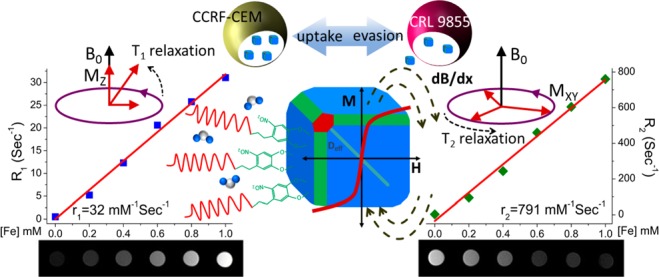- Record: found
- Abstract: found
- Article: not found
T 1- and T 2-weighted Magnetic Resonance Dual Contrast by Single Core Truncated Cubic Iron Oxide Nanoparticles with Abrupt Cellular Internalization and Immune Evasion

Read this article at
Abstract

Conventional T 1- or T 2-weighted single mode contrast-enhanced magnetic resonance imaging (MRI) may produce false results. Thereby, there is a need to develop dual contrast agents, T 1- and T 2-weighted, for more accurate MRI imaging. The dual contrast agents should possess high magnetic resonance (MR) relaxivities, targeted tumor linking, and minimum recognition by the immune system. We have developed nitrodopamine-PEG grafted single core truncated cubic iron oxide nanoparticles (ND-PEG-tNCIOs) capable of producing marked dual contrasts in MRI with enhanced longitudinal and transverse relaxivities of 32 ± 1.29 and 791 ± 38.39 mM –1 s –1, respectively. Furthermore, the ND-PEG-tNCIOs show excellent colloidal stability in physiological buffers and higher cellular internalization in cancerous cells than in phagocytic cells, indicating the immune evasive capability of the nanoparticles. These findings indicate that tNCIOs are strong candidates for dual contrast MRI imaging, which is vital for noninvasive real-time detection of nascent cancer cells in vivo and for monitoring stem cells transplants.
Related collections
Most cited references53
- Record: found
- Abstract: found
- Article: not found
Regulated portals of entry into the cell.
- Record: found
- Abstract: found
- Article: not found
Role of target geometry in phagocytosis.
- Record: found
- Abstract: found
- Article: not found
